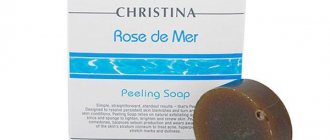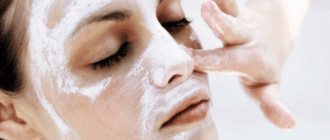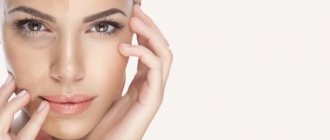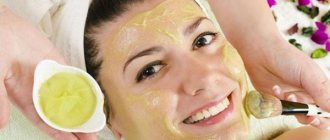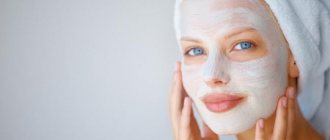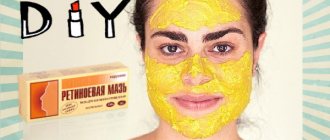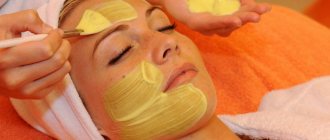You will undoubtedly be pleasantly surprised when you find out how beneficial milk peeling is for your facial skin. In cosmetology, it is one of the most effective drugs for combating skin imperfections.
And that's why:
- Lactic acid is an integral part of the skin's constituent components (natural moisturizing factor - NMF);
- Moisturizes, brightens, soothes the skin, reduces inflammatory manifestations, and also has an exfoliating effect;
- Refers to “summer” acids, that is, milk peeling can be used all year round;
Milk peeling is a targeted action on the skin with the aim of rejuvenating, moisturizing and superficially cleansing the skin, combating superficial wrinkles.
What is lactic acid
Lactic acid belongs to the group of alpha hydroxyl acids along with glycolic, mandelic and malic. The effect of using lactic acid is similar to the effect of procedures with glycolic acid, with the only exception that lactic acid is less aggressive. The skin after the procedure is less susceptible to irritation and better hydrated.
To carry out the procedure, you need to purchase lactic acid. You can buy it in pharmacies, veterinary pharmacies, and specialized soap-making stores. The most commonly found on sale is an 80% lactic acid solution. The cost ranges from 70 to 300 rubles per 100 ml.
In addition, you will need a neutralizing solution (soda and water), a brush for applying acid, Vaseline or fatty cream.
Properties
Lactic acid is formed both in foods under the influence of microorganisms and in muscles during intense training. It is produced by bacteria of the genus Lactobacillus and Streptococcus, as well as Rhizopus fungi. E270 is synthesized during fermentation; glucose, xylose and starch are converted into lactic acid with a decrease in the pH of this medium.
This mechanism has been used by humans for hundreds of years to preserve food, since the risk of spoilage is significantly reduced. In some vegetables this process occurs automatically due to the presence of lactic acid bacteria.
The food industry typically uses single bacteria such as Lactobacillus bulgaricus and Streptococcus thermophilus, which are added to pasteurized milk to produce yogurt. These microorganisms in the gastrointestinal tract help digest food and improve immunity.
Indications for the procedure
Lactopiling has many benefits for facial skin:
- skin exfoliation;
- deep cleansing of pores;
- stimulation of natural collagen production;
- lightening skin tone;
- reduction of hyperpigmentation;
- reducing the size and contrast of pigment spots;
- reducing the depth of wrinkles;
- relieving local inflammation;
- normalization of pH levels.
Advice. If you have not used chemical peeling before or have sensitive skin, then lactic acid peeling is the best choice. Lactic acid peels are perfect for mature skin, dry and oily skin types.
Are there any contraindications and side effects?
Any procedure, even the most harmless one, has contraindications. Milk peeling for the face is considered safe, so it can be done at home. However, even in this case, there are a small number of factors, the presence of which, the manipulation should be abandoned. This:
- Minor age;
- Lactation;
- Pregnancy;
- Malignant neoplasms on the skin;
- Tendency to form scar tissue;
- Recent depilation, solarium, tanning procedures;
- Spider veins on the face;
- Excessively sensitive skin;
- Presence of pigmented nevus;
- Individual intolerance to exfoliant;
- Aggravated herpes;
- Inflammatory processes on the face, purulent and other wounds.
You should be especially careful with chemical peels with high concentrations of lactic acid. This procedure should be carried out in a salon under the supervision of an experienced cosmetologist.
Even with a low concentration of exfoliant, it is necessary to strictly follow the instructions and not overexpose the active substance on the face and other parts of the body. With any peeling you need to know when to stop.
Peeling effectiveness
The result is not immediately noticeable. The gentle peeling action protects the skin from damage, but does not provide an immediate effect.
To eliminate visible inflammation, 2-3 procedures will be required. To lighten the tone - 2–4. Wrinkles will be reduced with regular use of peeling for 3-4 months.
The effectiveness of the procedure depends on the concentration of the solution:
- 10%–20% is a weak concentration. It is recommended for beginners to start with it.
- 30%–40% is average. You can switch to this concentration only after 3-4 sessions with a lower proportion of lactic acid in the composition.
- 50%–60% – strong exfoliating effect. Must be used with caution. And only after the skin adapts to the effects of lactopiling.
Exfoliation of the skin and cleansing of pores are the only visible effects immediately after applying the peel.
How does lactate affect the skin?
Under the influence of an acidic environment, the stratum corneum softens and becomes thinner, making the skin softer and more tender. Penetrating into the thickness of the sebaceous glands, lactate succeeds in liberating the ducts from plugs that are formed due to the accumulation of dirt, decorative cosmetics, excess sebum and exfoliated epithelium. Result: elimination of blackheads and prevention of inflammatory processes. The latter becomes possible thanks to lactions, which have an antibacterial effect.
Lactic acid applied to the skin provokes a slight, controlled burn, which does not cause harm, but activates regenerative processes, reducing them to 1 month (physiological norm!). In addition, as a result of milk peeling, it is possible to bind and evenly distribute moisture throughout the skin, which prevents the formation of dry areas.
Active production of ceramides under the influence of lactic acid improves the protective function of the skin. Stimulated fibroblasts increase the volume of hyaluronate synthesis, which ensures the full operation of water-saving mechanisms.
Lactic acid is also effective in matters of skin pigmentation. It not only perfectly exfoliates darkened areas, but also affects the production of tyrosinase, which is involved in the formation of melanin.
Preparation for the procedure
In summer, exposure to ultraviolet rays is aggressive. Avoid using peels in the summer if you are unable to stay at home for 3-4 days after the procedure. The best time to carry out manipulations related to skin renewal is late autumn, winter or early spring.
- Avoid products containing acids a week before your spa treatment. The skin should have time to rest and recover.
- Use only mild cleansers.
- Consult with your doctor about the use of the drug while taking OK.
- Stop using the facial scrub 2-3 days in advance.
- Stop smoking for 1-2 days the day before.
- Conduct a skin sensitivity test to the product. Apply the solution in the concentration you plan to use to the crook of your elbow. Monitor your skin reaction for 30–40 minutes. A slight tingling sensation at the site of application is a normal reaction.
- Do not use the peeling roller under 25 years of age.
After care
Not only preparation and proper execution are important, but also post-peeling care. When organizing it, they rely on protecting and moisturizing skin that is too delicate after procedures.
- Daily use of nourishing creams (selected according to skin type);
- The use of panthenol helps hydration and healing;
- The following oils are used as a “soothe” for the skin: shea butter, fireweed, and borage.
Other skin care products without abrasive particles can be used. Sunscreens (SPF 30 or higher) reduce the harmful effects of ultraviolet radiation. Remember that ultraviolet radiation causes premature aging and hyperpigmentation of the skin. After exfoliation, the skin is “bare”, so it especially needs additional protection.
Interesting: How to prepare and apply coffee facial scrub at home.
What not to do
- Use daily care creams and cleansers with alkaline, acidic components, as well as enzymes and citrus oils - up to 12 days;
- Touch and scratch the treated areas;
- Apply decorative cosmetics throughout the day;
- Subject the skin to prolonged thermal influence - bath, sauna;
- Long-term water procedures such as trips to the pool are not recommended.
Peeling progress
You will need:
- lactic acid;
- pH neutral cleanser;
- petrolatum;
- cloth napkin or small towel;
- application brush;
- pipette or measuring syringe;
- clean container for diluting acid;
- timer;
- moisturizing cream.
Peeling procedure:
- Prepare a neutralizing solution of cool water and baking soda in a 4:1 ratio.
- Dip a napkin into the solution so that it is well saturated with the solution.
- Prepare a solution of lactic acid in a container. Dilute the product with distilled water to obtain the desired concentration.
- Cleanse your face and pat dry with a towel.
- Apply Vaseline to all sensitive areas of the face to avoid exposure to them: the area around the eyes, the wings of the nose, the area around the lips.
- Using a brush, apply the peeling in horizontal motions to the face. Avoid repeated application of the composition to the same area.
- Note the time. For the first procedure, the exposure time is 30–40 seconds.
- Rinse off the peeling with cool water after the time has passed.
- Apply a cloth soaked in neutralizing solution to your face. Gently pat her face dry.
- Rinse off the neutralizer with clean water.
- Gently pat your face dry with a paper towel. Do not rub your face under any circumstances.
- Apply moisturizer or gel.
The exposure time of lactopilling will increase by 30 seconds with each procedure until it reaches 5 minutes. Apply the composition every six months, once a week for 5-6 weeks in a row.
Lactic acid is also used as a mask component for moisturizing and brightening. Here is the prescription:
- Prepare the necessary ingredients: 10 ml grapefruit juice, 20 ml natural yogurt or kefir, 3 ml 3% lactic acid.
- Apply a thin layer to the face and neck area.
- Leave the mask on for 20-30 minutes and then rinse off.
- Gently pat your face dry with a towel.
The mask is suitable for all skin types. Under the influence of lactic acid, facial skin is smoothed and moisturized. You need to use the mask 2-3 times a week.
Important! Do not use this or any other mask containing acids for at least a week after using the gel.
Methodology at home
To ensure that the procedure carried out at home is as safe and effective as possible, you should adhere to the technology of its implementation:
- The preparatory stage includes 10−14 days before the procedure. During this period, you should not visit beaches and solariums, or use sunscreen. In your daily care you should include products such as lotions, tonics and creams with low concentrations of fermented lactic and fruit acids. This will prepare the dermis for the effects of acid in large quantities.
- Cleansing is carried out immediately before the procedure. To do this, you can use cleansers that you use daily. After removing impurities and cosmetics from the skin, it is also worth wiping it with a toner containing alcohol or a small amount of acid (lactic or fruit) in the composition. This will have a degreasing effect. The area around the mouth and eyes should be untouched. At this stage, you can protect it by applying a thick cream or Vaseline.
- Carrying out peeling with fermented milk products. Apply the prepared solution with a cotton pad or brush. The acid should not drip when applied, as it may get on the lips or in the eyes. Treatment should begin with the cheeks and forehead, moving along the massage lines. For the first procedure, 1 minute is enough. Afterwards it is worth looking at the reaction of the dermis. If there are burning or tingling sensations, but they are tolerable, then you can endure the procedure completely. But if you feel a strong burning sensation, then the composition should be washed off immediately, otherwise you may get a burn or irritation.
- The completion of the procedure consists of properly washing off the remaining mixture. To avoid aggravating the situation due to the exfoliating process, products should be removed only with cold or cool water in large volumes. Using warm or hot water, rushing, saving resources can cause irritation. After the mask is washed off, dry your face with gentle wetting movements with a soft towel. You can apply a nourishing cream, make a moisturizing or soothing mask as a finishing touch.
The optimal number of procedures is 5 sessions with an interval of 10 days.
It is not recommended to be in the sun after peeling; you must apply sunscreen to your face when going outside.
Healing period
After peeling, facial skin is super sensitive. She's annoyed. Redness is a normal reaction. Peeling may begin after 2-3 treatments. If the acid dosage is incorrect or the application technology is violated, burn crusts may form on the face. Do not remove them mechanically yourself. This can lead to skin infection.
Use a high SPF sunscreen. Avoid skin exposure to sunlight. Complete your outdoor look with a wide-brimmed hat and sunglasses.
If on the third day after applying the composition the itching and redness do not go away, then be sure to seek advice from a specialist.
Do not use exfoliating products for a week after using the acid.
How to get rid of acne?
Alpha hydroxy acid (AHA) is an essential metabolic product in the human body, a component of the skin's natural moisturizing factor. Obtained from whey.
In cosmetics, lactic acid plays a role similar to other AHAs: moisturizes the skin, normalizes the process of epidermal cell renewal, which slows down with age; enhances the synthesis of lycosaminoglycans and collagen in the dermis.
The effect of lactic acid that is distinctive from other AHAs is that it helps strengthen the lipid barrier of the skin by increasing the synthesis of linoleate-containing ceramides. The external manifestations of this process are an improvement in complexion, increased hydration, elasticity and firmness of the skin, and a decrease in the depth of wrinkles.
Lactic acid normalizes the process of epithelization in the excretory ducts of the sebaceous glands and the mouths of hair follicles, reduces the density of comedones and pore sizes and, thanks to this property, is used in products for the care of problematic and oily skin.
In cosmetics for home use, the concentration of AHA acids should not exceed 4%.
INCI: Lactic Acid Synonyms: α-hydroxypropionic acid, hydroxypropionic acid Molecular formula: CH3CH(OH)COOH
Physico-chemical properties: Appearance - colorless crystalline powder Molecular weight - 90.1 pH of aqueous solutions - 1.23 (37.3%) - 0.2 (84.0%) Solubility: Water at 20°C - unlimited From -due to the high hygroscopicity of lactic acid, its concentrated aqueous solutions are usually used - syrupy, colorless, odorless liquids.
Description: In nature, lactic acid is formed as a result of lactic acid fermentation (during souring of milk, sauerkraut, pickling vegetables, ripening cheese, ensiling feed); D-lactic acid is found in the tissues of animals, plants, and also in microorganisms.
Properties: Lactic acid is used in the food and cosmetics industry, in mordant dyeing, in tanning, in fermentation shops as a bactericide, for the production of medicines, plasticizers.
As everyone knows, milk - this tasty and healthy product - helps strengthen the immune system and deliver vitamins and nutrients to the body. The latter, however, are also useful for external use! It’s not for nothing that masks, creams and other cosmetics have been made from milk for a long time. The properties of lactic acid were skillfully used back in Ancient Egypt. As you know, Queen Cleopatra loved to take rejuvenating baths with whey, the active ingredient of which was lactic acid. They were called “Cleopatra’s bath” and became one of the most ancient examples of anti-aging therapy.
Beneficial properties of lactic acid: 1. Lactic acid has a whitening, moisturizing and anti-inflammatory effect, 2. Produces a brightening and whitening effect, 3. Promotes exfoliation of dead skin cells, 4. Strengthens and refreshes dehydrated, sagging skin, 5. Has a smoothing effect, therefore Recommended for skin with finely wrinkled aging.
The use of lactic acid helps to: 1. Reduce the depth of fine wrinkles; 2. Improving elasticity, turgor and skin color; 3. Lightening pigmentation; 4. Reduce acne on oily skin; 5. Reducing the size of stretch marks; 6. Treatment of sensitive, allergic skin.
Milk peeling is applied in a course of three to six procedures with an interval of about two weeks. Remember that before the procedures, during the course of treatment and at least 10-14 days after the end of the course, it is necessary to avoid solar (UV) radiation.
Milk peeling gives a pronounced rejuvenating effect, comparable in results to a facelift, improves and smoothes skin structures, enhances skin tissue regeneration, promotes collagen synthesis, whitens and moisturizes the skin.
Application: - shampoos - creams, lotions, tonics - peeling masks
Dosages for creams, tonics: 0.1-0.5% Dosages for home peelings: maximum 4%
Peeling with lactic acid at home
You will need:
- Lactic acid solution
- Cotton pads
- Hair dryer
- Rubbing alcohol or witch hazel tincture
1. First of all, decide which peeling is suitable for your skin. The concentration of lactic acid peels varies from 30% to 70%. If you are doing peeling for the first time, it is better to start with a concentration of 30%-40%.
2. Wash your face with a mild cleanser and pat your skin dry with a towel. Wipe your face with a cotton pad soaked in rubbing alcohol or witch hazel tincture. This will remove any fat from your skin that may still be there.
3. Apply enough peeling solution to a cotton pad so that the cotton pad is generously moistened with it. The cotton wool should be well soaked in the solution, but not so much that liquid drips from it. Wipe your entire face, starting from the forehead and working your way down. Stay away from the eyes and also avoid the delicate skin that surrounds the eyes. Avoid touching your lips and the area between your nose and lips. Then note the time. For the first time, leave the lactic acid peel on the skin for only 1-2 minutes. As your skin gets used to the peel, you can increase the time little by little, but if you leave the acid solution on your face for too long the first time, your skin may get chemically burned and result in scars. When the time is up, rinse your face thoroughly with cold water.
Notes:
- If you feel discomfort after applying the solution, cold air from a hairdryer will reduce the pain.
- If you apply Vaseline to the area around your eyes, between your nose and lips, and on your lips before the procedure, you will help protect the delicate skin in these areas from excessive dryness.
- Keep track of the time!
- Rinse off the solution only with cold water. If you rinse your skin immediately after peeling with hot water, it may become irritated.
- It is best not to apply creams containing alpha and beta hydroxy acids and retinoids to your skin immediately after peeling. You can do this 24-48 hours later.
- When the skin gets used to repeated peeling, you can increase the duration of the procedure. After several procedures, you can even apply peeling to the skin again for 1 minute. Under no circumstances do this for the first time.
- You can lubricate your skin after peeling with a light moisturizer.
- Do not use a peeling solution with a high concentration of acid, no matter how much you want to enhance the effect. We all want to have beautiful skin, but to achieve this we need to be patient. Several procedures performed weekly or every two weeks over several months will give excellent results.
Where can I buy?
The most affordable option is to purchase it at a pet store. Or buy it in a specialized store.
How to dilute?
That is, 1 part lactic acid 10 ml and for example 1 part water 10 ml, then it will be 40%. In total we will get 20 ml of 40% lactic acid, add another 20 ml of water and it will be 20%.
Unlike glycolic acid, lactic acid is not as caustic and does not need to be quenched.
What do the professionals advise?
It is better that the concentration in your products does not exceed the recommended 4%. I would not recommend doing professional peeling products at home unless you are a professional in this field. You can moisten the gauze with a 4% solution and apply it to your face or prepare a cream containing 4% lactic acid. The tonic, it seems to me, is simply not very convenient to use. You can perform up to 2 procedures per week. Under the eyes - try 2%. Keep it until the first unpleasant sensations appear (but no more than 20 minutes). At the end of the procedure, you can lubricate your face with a fatty oil, such as jojoba.
It’s better to make your own tonic, at least in the form of a 1-3% solution of lactic acid in water. Because If you have 80% lactic acid, then 1.25% of this 80% solution = 1% pure lactic acid.
100 g of fatty kefir contains 0.9 g of lactic acid, i.e. 0.9%.
So, today I tried to do peeling on the skin of my stomach, my skin is delicate and sensitive, if something was wrong it would immediately react.
I have lactic acid (LA) 80%, I diluted it: for 5 ml of lactic acid 5 ml of water. The mixture turned out to be slightly viscous, yellowish in color, with a slight smell of fermentation. Even though it was oily, it spread very well right over the skin.
I applied it for 5 minutes, after 3 minutes a burning sensation began, not much, quite tolerable, the skin did not turn red, it just burned. After five minutes I washed it off, while I was washing it off I felt like my skin was burning a little. Apparently, nothing happened after that: the color was the same, the skin reacts to the touch - it burns.
Reviews: 1. back2me Used to remove age spots, blackheads and pimples. In addition, the skin becomes very smooth afterwards. Bottom line: I started using 40% MK all over my face for about 5 minutes and worked up to about 10 minutes. By that time, the skin stopped reacting so much, it didn’t burn as much. Then I switched to 88% and replaced all my acne treatments with MK. I noticed that if a new pimple pops out, if you apply 88% MK to it precisely, the pimple disappears in the shortest possible time. I do not recommend leaving MK on the skin for more than 10 minutes; even if you spot it, you will get a severe burn!!! I was able to get rid of moderate acne.
2. Streeter Reduces cystic acne, reduces sebum production. Pimples began to appear more often when BP and salicylic acid stopped helping, so I decided to try MK 50%. The first time I applied it for 1 minute, nothing happened, then I washed it off. The next day I applied it for 3 minutes and felt a slight burning sensation, but my face didn’t even turn red. I noticed that if lactic acid is left overnight, spot on, 50% MK, then acne the next day disappears by 80%. This is a miracle!!! I could not believe it. I also noticed that the oil content decreased and the skin became smooth. And most importantly it is cheap and effective.
In general, there are a lot of good reviews from those who didn’t have allergies: - it helps against acne, and it clears it up for almost everyone. - makes the skin even and smooth. — removes enlarged pores, — gets rid of blackheads and scars that are not very pronounced. Of the minuses: - burns, start with a small dosage! - peeling, usually occurs on the 4th day. Use a mitten or scrub. - hyperpigmentation increases, use sun protection.
My review:
I did a lactic acid peel on my face. to 12 parts water, added 10 parts lactic acid 80%
I could barely stand it for 2 minutes, my face was just burning, 20 seconds after application. Then I washed it off, probably for a long time, with cold water. Afterwards, my face was red, either from washing or from peeling.
An hour later, the complexion began to even out and was already pink, in some places there were still large red spots. In general, the skin reacted to the peeling.
Only the next day the complexion became the same.
The effect of the peeling: - I was surprised that the blackheads immediately lightened up all over the nose, although after 3 days they came out again, - the skin tightened, if in some places it seemed slightly wrinkled, then everything smoothed out perfectly. - the pores have become better visible, most likely due to the fact that the skin is thickened and until everything is completely smoothed out, the effect will remain the same. — there was one pimple that was going to come out, but it never came out, it didn’t fester, it’s still dissolving inside. — the skin began to peel off, peeling off in large flakes, now I only wash myself with a mitten.
It’s better not to smear it with foundation, it’s immediately obvious that it’s generally a molting period.
Precautionary measures
An important point is the gradual increase in the time of exposure of the skin to lactopiling.
In addition, it is important to know in which cases the use of the ray is contraindicated:
- herpes in the active phase;
- pregnancy and lactation period;
- presence of open wounds on the face;
- varicose veins;
- recent trip to the beach or solarium;
- nevus on the face;
- oncological diseases.
Avoid epilating any area of the face 3 days before using acid.
What should you know?
Please note: some manufacturers produce milk peeling preparations that act excessively harsh on the skin, so that the effect of the procedure can no longer be called superficial. It is necessary to find out from a specialist which manufacturer’s product he is using and how active the effect of this drug is.
You should also find out what components the drug used by the specialist includes. Unscrupulous manufacturers use hydroquinone to better whiten the skin, and this component is dangerous because it negatively affects the endocrine organs. It was banned in many countries.
It is important to know that some moisturizing creams contain glycerin. At a certain air humidity, this substance begins to extract moisture from the depths of the skin, “locking” it on top
And a similar effect prevents water from being obtained from the air. As a result, the skin becomes dry.
Advantages and disadvantages
This method of exfoliation has enough advantages:
- the procedure is painless;
- composition is hypoallergenic;
- sensitivity to ultraviolet radiation is not as high as when using other acids;
- budget cost;
- the ability to carry out the procedure independently;
- low likelihood of side effects (itching, burning).
However, there are also disadvantages:
- low effectiveness of milk peeling after 35 years;
- lack of immediate effect;
- high danger to vision if the composition gets into the eyes.
Reviews of milk peeling
Having studied reviews of facial cleansing with lactic acid, we concluded that the procedure is popular both among clients of beauty salons and among lovers of home skin care. Here are some interesting statements.
And also the most visual photos before and after a milk peeling session.
Patient reviews
Patients' opinions were divided. The condition of the skin at the time of the procedure and age are the main criteria affecting the effectiveness of the method. In the absence of problems with facial skin, it is difficult for the patient to note the high effectiveness of the drug. However, it notes the absence of side effects.
Owners of dry skin, girls suffering from post-acne, rosacea, respond positively to the use of lactopilling. A decrease in unaesthetic manifestations and an increase in the level of skin moisture are noted.
The best products for milk peeling
The most effective and popular means include:
- Compliment - good for working with dry skin. Moisturizes, cleanses. Improper use may cause severe irritation;
- Aravia - selected for people with oily skin types. Provokes narrowing of pores, removes excess sebum;
- Tian De is effective in combating the stratum corneum and acne. Removes hyperpigmentation;
- Sesderma - used for young skin. Organizes treatment and prevention of rashes.
The purchase of the above products must be agreed upon with a dermatologist.

